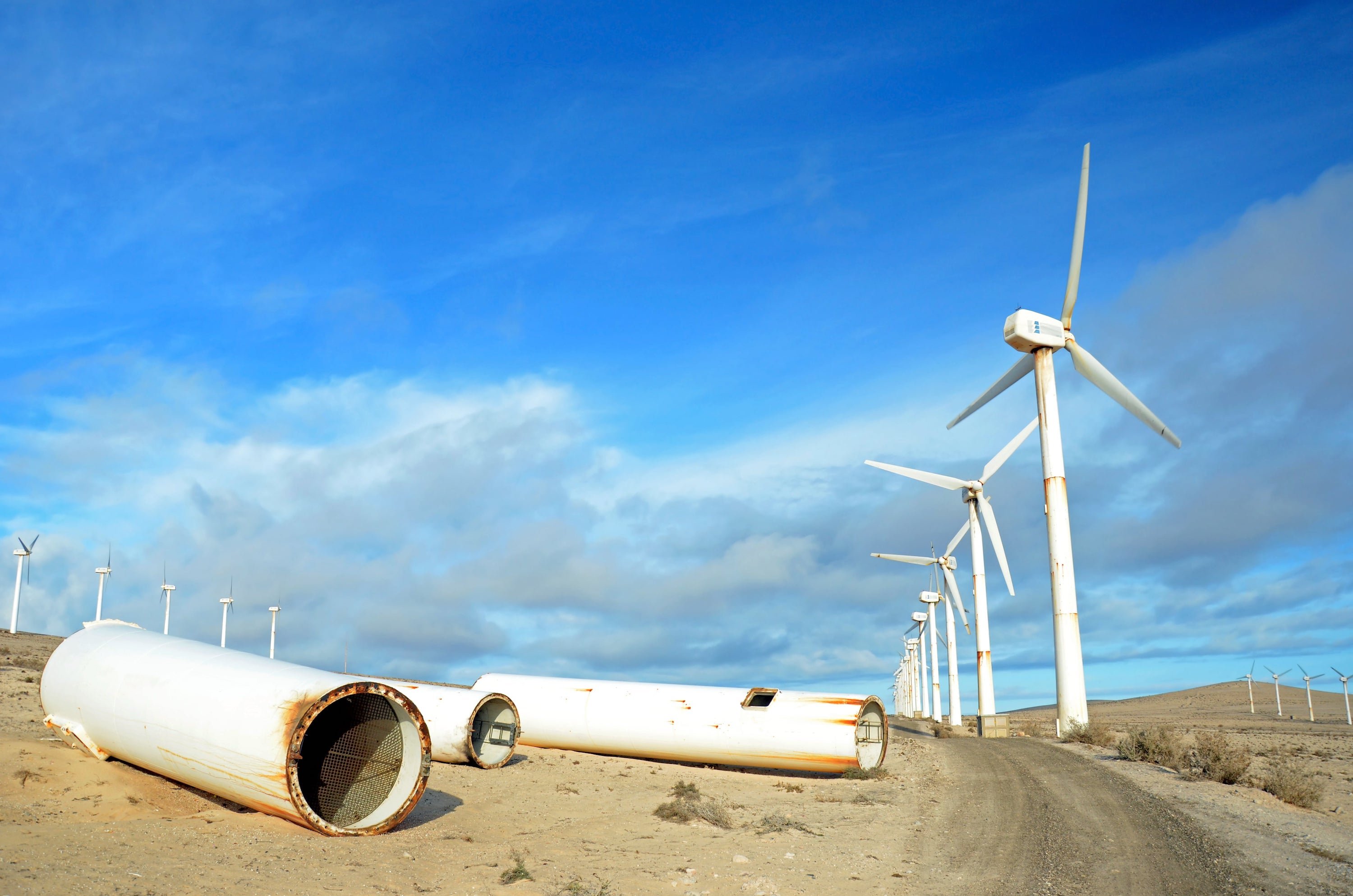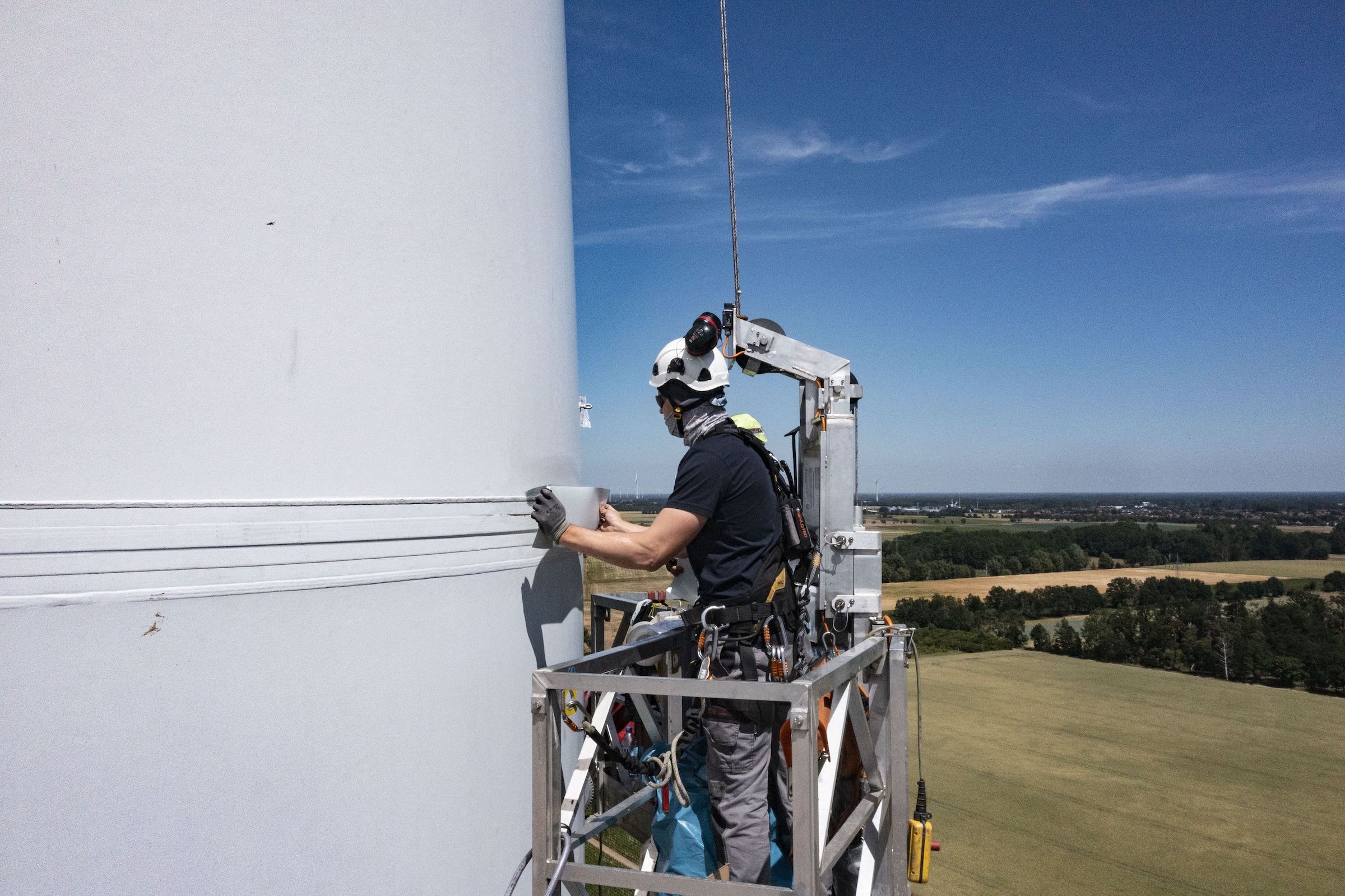The construction and operation of a wind farm requires a large number of technical components that transport the generated electricity safely, ...
If we look back a few decades, wind turbines were still installed on comparatively low lattice masts. No wonder – the rated output of the first generations of wind turbines was still in the low kilowatt range. Today's multi-megawatt wind turbines are significantly more powerful and therefore reach many times higher into the sky. The hub heights and thus also the towers of modern wind turbines now easily exceed those of Cologne Cathedral. Steel tubular towers are the most common type, both for onshore and offshore wind turbines.
Steel towers are significantly lighter than their reinforced concrete counterparts, which can easily weigh five to six times as much for the same height. They consist of several segments, each 20 to 30 metres long, which are welded together. However, even though steel is a very robust material, rain, snow, hail, wave action, salty sea air and up to ten million load cycles over the years do not leave the towers of wind turbines undamaged. The risk: corrosion. What dangers does corrosion pose to wind turbines, where is it particularly dangerous, and what protects the turbine permanently and reliably against corrosion damage? We address these and other questions in this article.
Of all the damage that can occur to wind turbines during their service life, corrosion is not necessarily the type that receives the most attention from operators. Yet corrosion damage is by no means rare – which is not surprising when you consider the harsh weather conditions that onshore and offshore wind turbines are exposed to in their exposed locations.
Add to this the daily dynamic loads, and the result is a risk of corrosion that should not be underestimated and that causes far more than just unpleasant visual damage. Over time, corrosion damage can progress to such an extent that it can even threaten the stability of a wind turbine.
In this context, screw and welded connections, and especially flanges, come into focus. This is because the capillary action of liquids repeatedly comes into play here. We encounter capillary force in everyday life, for example when liquid wax rises in the wick and thus supplies the candle flame with its fuel. Or when the ink in the cartridge flows from inside the fountain pen to the nib. Or when we put a straw in a glass of drink and the level of liquid in the tube rises higher than the water surface in the glass.

Put simply, capillarity is based on the effect that the weight of liquids in narrow cavities is low and capillary force outweighs gravity. This is how water travels from the roots to the top of a tree – up to 100 metres high.
In wind turbines, this capillary effect is undesirable, of course, but the ingress, or rather the absorption, of rainwater and condensation in critical areas such as flanges greatly promotes the formation of corrosion. If the bolts are damaged, the repair costs can quickly amount to tens of thousands of pounds – especially if experts assess that the complete replacement of the bolts is essential for the stability of the turbine in the event of corrosion of just a single bolt.
In the worst case, the wind turbine may even be classified as a total economic loss in a recommissioning report. Prevention is therefore the best strategy. In our experience, close monitoring of the corrosion process and the fastest possible containment and repair of damage can, save around 77 per cent of the costs that would otherwise be required to replace the bolts.
Wind turbine towers are generally protected against corrosion by a coat of paint applied at the factory, but this protective coating is not invulnerable. In offshore and nearshore areas, where corrosion occurs more frequently on wind turbines than inland due to the aggressive environmental conditions, damage must be resealed with paint more often. However, painting work is both weather-dependent and associated with downtime. After all, three coats of paint usually have to be applied and left to dry in between. During this work, paint or sticky corrosion compound can drip into the sea – unintentionally, but unavoidably. Film solutions, which are usually applied in a two-coat system, are significantly more time-saving and pose no such risks to people or the environment.
Corrosion on wind turbines cannot be prevented entirely. In addition to the weather conditions mentioned above, there are also human factors that can lead to corrosion damage – for example, on surfaces where technicians frequently move around and bump into the tower with their tools.
Regardless of how the corrosion ultimately occurred, operators should always respond to damage promptly, in particular, before the deadlines for recommissioning reports expire. This is especially important when the stability of the turbine must be ensured, because critical areas such as flange connections are affected.
Large rust spots and streaks on the tower surfaces, on the other hand, are much easier to identify as obvious defects. Therefore, they can and should be repaired earlier – but this does not mean that small areas of damage do not have the potential to develop into extensive corrosion damage over time.
Corrosion on wind turbines cannot be prevented entirely. So there are a number of corrosion protection systems available, each with its own advantages and disadvantages. These range from corrosion protection films and spray-on corrosion protection coatings to all-in-one compounds in cartridge form, which are used to repair corrosion damage.
However, sprayed-on corrosion protection reaches its limits in transition areas such as the flange. While it can be easily applied to the outside and inside of the tower segments, this is not possible at the most critical point: the flange plates. This is due to the large forces acting on them, which would cause the protective layer to break very quickly. A practical solution for the flange area therefore lies, among other things, in flexible sealing tapes, the application of these tapes requires several steps or leaves unsightly residues on the plant, which in turn have to be removed.
High-quality plastic films are used worldwide in numerous key industries – including, for example, construction, housing and living, visual communication, healthcare and, last but not least, the automotive industry. Typical examples of applications include window frames and profiles, floor and wall coverings, advertising prints, glass decoration applications and car wrapping, where entire vehicles can be easily redesigned using self-adhesive film.
The main reasons for using films are their durability and stability, the variety of colours and designs available, their good printability and their resource-saving production and processing. In addition, if desired, the original condition can be restored by removing the film. A relatively new application is the use of film as corrosion protection. However, given the excellent product properties and ease of application, it should only be a matter of time before films become established in this area as well.
Any downtime of wind turbines – whether involuntary due to malfunctions or planned repairs – means lost revenue for operators and therefore costs a lot of money. This makes the advantages of using corrosion protection films such as RENOLIT CP in the wind energy industry all the greater, as they offer both extremely durable protection and ideal conditions for application in every respect: while other corrosion protection coating systems consist of two or three layers, RENOLIT CP requires only a primer. This is applied after cleaning the surface. Once it has dried thoroughly, the film can be applied – both to the tower surfaces and the flange areas.
The application is significantly less dependent on the weather than painting would be: temperature fluctuations or precipitation shortly after applying the corrosion protection film have no negative effect on the end result. Layer thickness variations, such as those that can occur with manual painting, are a thing of the past with this film solution. All of these benefits make the application of the corrosion protection film flexible to plan and reduces downtime of wind turbines to a minimum.

RENOLIT is currently developing further concepts to reduce the overall application time of the system even further. The time-saving aspect is particularly important for offshore applications. Additionally, RENOLIT CP offers user- and environmentally friendly benefits, as no volatile organic compounds are used during application, and there is no risk of contamination or environmental pollution from dripping paint. Thanks to the high-quality standards of the production processes, wind turbine operators benefit from a corrosion protection system with a service life of ten years. This reduces the use of valuable resources.
To validate the system, a complex corrosion test in accordance with the CX standard was commissioned from an independent testing institute. RENOLIT CP demonstrated outstanding properties and was therefore awarded the ISO 12944-9 CX standard. In addition, the film has already been used successfully in several pilot projects, the longest of which has been running for over three years. RENOLIT demonstrated excellent adhesive strength, while no corrosion has subsequently appeared.
Every wind turbine – whether onshore or offshore – requires a service and maintenance concept that ensures the longest possible service life with maximum plant availability. Corrosion as a source of damage should not be neglected, as environmental influences such as rain, snow, frost, UV light and salty sea air have negative impact on a large surface area between the hub and the foundation.
Whether it's about vulnerable areas such as screw connections, welded joints or flanges – all of these, as well as the surface of the tower segments, must be protected as effectively as possible from harsh external influences. Corrosion protection films such as RENOLIT CP offer excellent properties for this purpose, which have proven themselves in both pilot projects and in the field. The motto “film instead of paint” is interesting for wind turbine operators because unlike protective coatings, films are much easier to apply, more flexible and less dependent on weather conditions, while downtime is reduced to a minimum.
The construction and operation of a wind farm requires a large number of technical components that transport the generated electricity safely, ...
After ten to twenty years of operation, wind turbines often reach the point where central components reach their wear limits. Large components such as ...
12 November 2025 | 5:00 p.m. | Forum 42 | Wind Energy Days Potsdam
Turbit has published research addressing a fundamental challenge in wind operations: extracting reliable answers from large sets of recurring ...